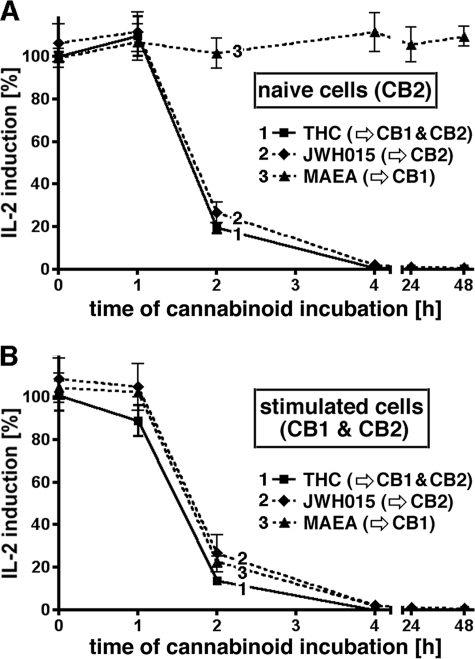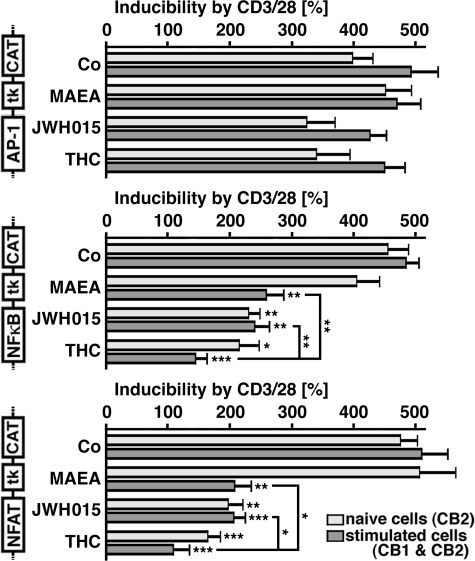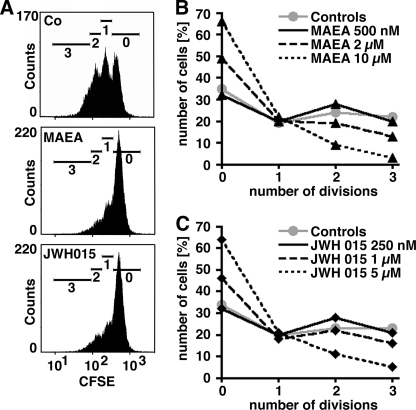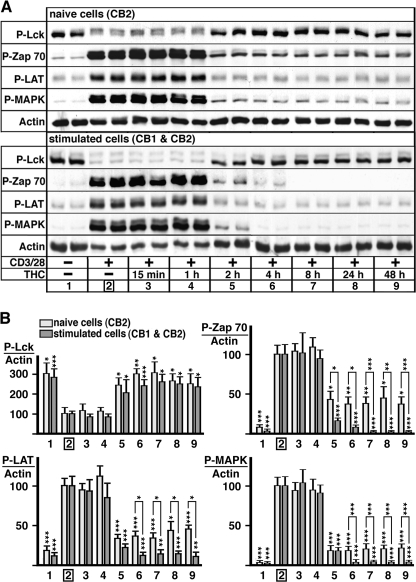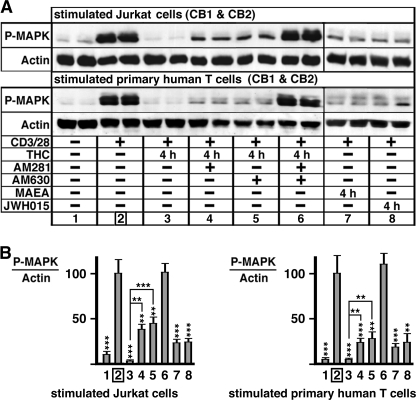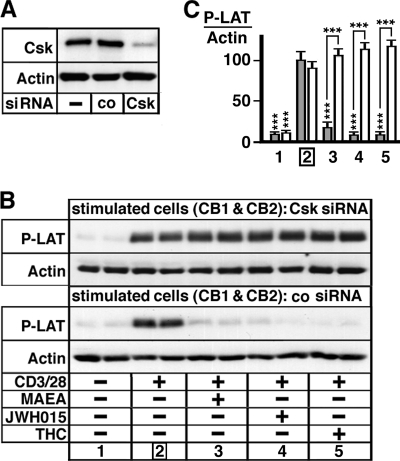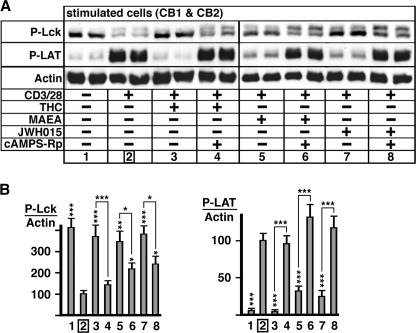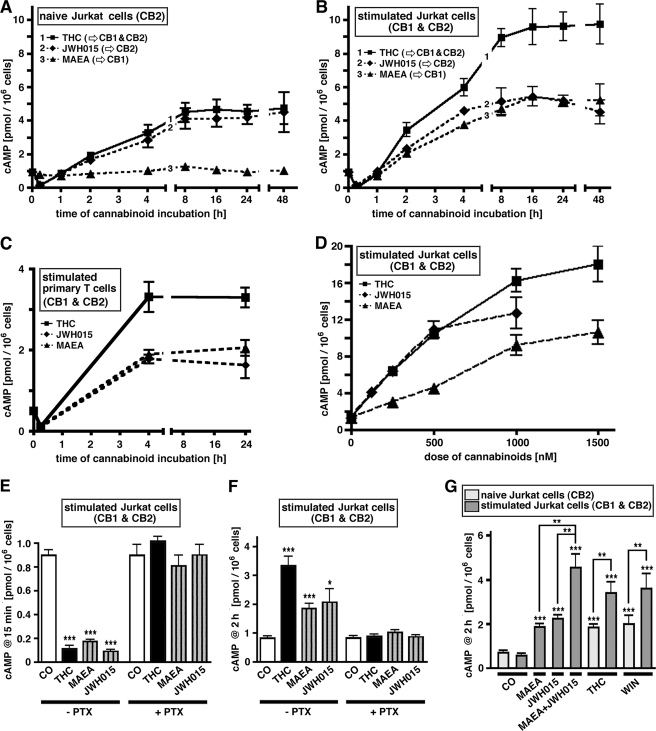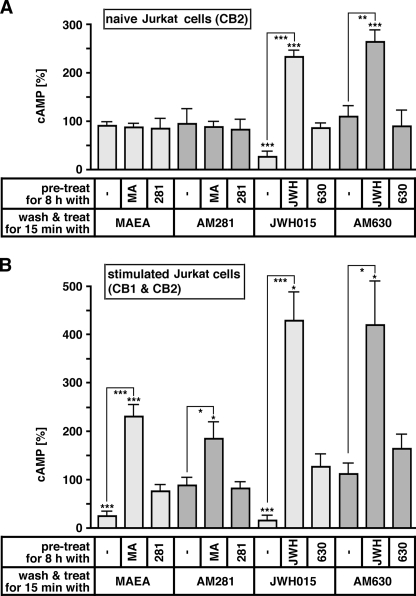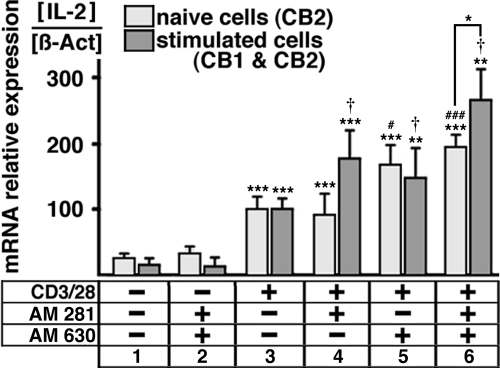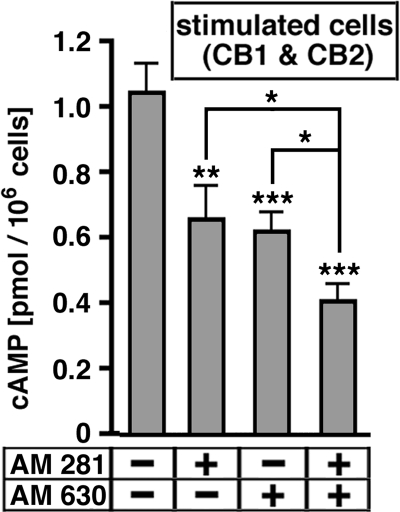Abstract
The aim of this study was to characterize inhibitory mechanisms on T cell receptor signaling mediated by the cannabinoid receptors CB1 and CB2. Both receptors are coupled to Gi/o proteins, which are associated with inhibition of cyclic AMP formation. In human primary and Jurkat T lymphocytes, activation of CB1 by R(+)-methanandamide, CB2 by JWH015, and both by Δ9-tetrahydrocannabinol induced a short decrease in cyclic AMP lasting less than 1 h. However, this decrease was followed by a massive (up to 10-fold) and sustained (at least up to 48 h) increase in cyclic AMP. Mediated by the cyclic AMP-activated protein kinase A and C-terminal Src kinase, the cannabinoids induced a stable phosphorylation of the inhibitory Tyr-505 of the leukocyte-specific protein tyrosine kinase (Lck). By thus arresting Lck in its inhibited form, the cannabinoids prevented the dephosphorylation of Lck at Tyr-505 in response to T cell receptor activation, which is necessary for the subsequent initiation of T cell receptor signaling. In this way the cannabinoids inhibited the T cell receptor-triggered signaling, i.e. the activation of the ζ-chain-associated protein kinase of 70 kDa, the linker for activation of T cells, MAPK, the induction of interleukin-2, and T cell proliferation. All of the effects of the cannabinoids were blocked by the CB1 and CB2 antagonists AM281 and AM630. These findings help to better understand the immunosuppressive effects of cannabinoids and explain the beneficial effects of these drugs in the treatment of T cell-mediated autoimmune disorders like multiple sclerosis.
Introduction
Cannabinoids are discussed as drugs for the treatment of neuroinflammatory diseases and T cell-mediated autoimmune disorders such as, for example, multiple sclerosis. Their potential usefulness for such disorders is emphasized by the fact that cannabinoids affect functions of both neuronal and immune effector cells. Cannabinoids produce a variety of immunomodulatory effects (reviewed in Refs. 1 and 2). Among these effects, the cannabinoid-mediated inhibition of interleukin (IL)-22 production of activated T lymphocytes (3, 4) may be beneficial in the above mentioned diseases but on the other hand may also cause immunosuppression. Many effects of endogenous cannabinoids like anandamide and exogenous cannabinoids like Δ9-tetrahydrocannabinol (THC), the psychoactive compound of Cannabis sativa, are mediated by the Gi/o protein-coupled cannabinoid receptors CB1 and CB2. While CB1 was found to be expressed predominantly in neuronal cells and only to a lesser extend in peripheral cells like immune effector cells, CB2 was considered to be the “peripheral” cannabinoid receptor, being expressed in cells of the immune system (5). However, recent reports suggest the expression of CB2 in neuronal cells, as well (6, 7). Moreover, although normally expressed in very low amounts only, recent work from our laboratory demonstrated a massive up-regulation of functional CB1 receptors in T lymphocytes in response to cannabinoids themselves, IL-4, and T cell activation (8–10). In addition, a number of other receptors have been shown to mediate the effects of cannabinoids, which include vanilloid receptors, peroxisome proliferator-activated receptors and the formerly “orphan” designated receptors GPR55 and GPR119 (reviewed in Ref. 11).
Despite of a number of reports, it remains largely unresolved which types of cannabinoid receptors mediate IL-2 inhibition and what are the detailed molecular mechanisms. With regard to the receptors, it was demonstrated independently by different groups, using either selective agonists and antagonists (12) or transgenic mice lacking CB2 (13) that CB2 is involved in mediating the effect of cannabinoids on IL-2. However, it was also suggested that neither CB1 nor CB2 receptors mediated the effect of cannabinoids on IL-2 (14). Recently, it was reported that the inhibitory effect of the endogenous cannabinoid 2-arachidonyl glycerol on IL-2 production in T cells was dependent on peroxisome proliferator-activated receptor γ (15). Thus far, no reports showed involvement of CB1 in the cannabinoid-mediated inhibition of IL-2, which is probably due to the fact that high amounts of CB1 are only present in T cells after defined stimulation of the cells (see above). With regard to the mechanisms of the cannabinoid-mediated inhibition of IL-2, it was shown that the drugs inhibit the T cell receptor (TCR)-induced activities of the transcription factors NF-κB and NFAT (4, 16, 17). This is interesting, because it is known that the expression of IL-2 in activated T cells is almost exclusively regulated at the level of transcription by these factors. In addition, it was shown that activation of the mitogen-activated protein kinase (MAPK) is inhibited by cannabinoids in lymphocytes (18). However, detailed molecular mechanisms linking the effects of cannabinoids to the TCR-triggered signaling are missing and will be the topic of this communication.
The TCR-mediated activation of T cells induces a defined signaling cascade, at the end point of which transcription of IL-2 is induced (19–21). In nonactivated, resting T cells, this cascade is tonically repressed by constitutive phosphorylation of the negative regulatory site of the leukocyte-specific protein tyrosine kinase (Lck) at Tyr-505. This phosphorylation is mediated by the C-terminal Src kinase (Csk) (22). Upon engagement of the TCR, the inhibitory effect of Csk on Lck is abolished allowing initiation of the TCR-induced signaling cascade (23–25). One of the earliest events in this cascade is then the phosphorylation and thereby the activation of the ζ-chain-associated protein kinase of 70 kDa (Zap 70). Activated Zap 70 in turn phosphorylates the adaptor protein linker for activation of T cells (LAT), leading to the induction of calcium flux and activation of the MAPK cascades. In this way, the signal is transduced, and the transcription factors AP-1, NF-κB, and NFAT are activated and finally transactivate the IL-2 gene. After being released, IL-2 induces a variety of well defined subsequent immune responses (26). It is known that the activity of Csk to phosphorylate the negative regulatory site of Lck at Tyr-505 can be further enhanced by cAMP-dependent protein kinase A (PKA). Thus, PKA exhibits an inhibitory effect upon TCR signaling by stabilizing the inhibited state of Lck (27, 28). Here we report on the molecular linkage between CB1 and CB2 and T cell signaling and present a mechanism by which cannabinoids inhibit IL-2 production of activated human T cells via these receptors.
EXPERIMENTAL PROCEDURES
T Cell Culture, Induction of CB1, T Cell Activation, and Reagents
Peripheral blood mononuclear cells were isolated from heparinized blood collected from healthy volunteers as described (29). Primary human T cells and the human T cell line Jurkat (Kab 14) were cultivated in RPMI 1640 medium (Lonza Verviers SPRL, Verviers, Belgium) supplemented with 10% fetal calf serum and antibiotics (100 units/ml penicillin and 100 mg/ml streptomycin; Lonza Verviers SPRL). We would like to note that no cannabinoid receptor-overexpressing cells were used in our experiments. CB2 is expressed in the naive cells constitutively. The endogenous CB1 was induced by stimulation of the cells with IL-4 as described (9). Briefly, the cells received IL-4 (5 ng/ml; R & D Systems, Wiesbaden, Germany) and were incubated for 3 days. Then the medium was replaced by fresh medium without IL-4, and the cells were cultured for additional 24 h. An aliquot of the cells was tested to assure the induction of CB1 transcripts (data not shown). For these cells, the terms “stimulated cells” or “CB1- and CB2-expressing cells” will be used. T cells were activated with 100 μl of each anti-CD3 monoclonal antibodies (OKT3) and anti-CD28 monoclonal antibodies (248.23.2) obtained from hybridoma supernatants produced in our laboratories (29). Cannabinoid agonists were THC, which activates CB1 and CB2 (Sigma), metanandamide with a preference for CB1 (MAEA; Sigma), JWH015 with a preference for CB2 (Tocris, Bristol, UK), and WIN 55,212-2 mesylate, which activates CB1 and CB2 (Tocris). Antagonists were AM281 (selective for CB1: Ki of CB1, 12 nm; Ki of CB2, 4200 nm; Tocris) and AM630 (selective for CB2: Ki of CB1, 5152 nm; Ki of CB2, 31.2 nm; Tocris). The Ki values were taken from Ref. 5. The PKA inhibitor (R)-adenosine, cyclic 3′,5′-hydrogenphosphorothioate (cAMPS-Rp; Tocris) was used at 100 μm.
Quantitative Real Time Reverse Transcription-PCR
Per sample, 106 Jurkat cells were used. The isolation of total RNA and cDNA synthesis is described earlier (8). The PCRs were done in a total volume of 20 μl on a LightCycler instrument using the LightCycler-Fast Start DNA Master SYBR Green I kit (both from Roche) according to the manufacturer's suggestions. Primers and conditions for the PCRs specific for β-actin, CB1, and CB2 are described in detail earlier (8). The PCRs for IL-2 transcripts were performed with 5′-GAAGGCCACAGAACTGAAACATCT-3′ and 5′-CTGTTCAGAAATTCTACAATGGTTG-3′ primers, with a preincubation for 8 min at 95 °C and 50 cycles with 5 s at 95 °C, 5 s at 65 °C, and 10 s at 72 °C (specific Tm = 81,75 °C).
Proliferation Assay
The cells were washed once with phosphate-buffered saline and loaded with 0.1 μm carboxyfluorescein succinimidyl ester (CFSE; Molecular Probes, Göttingen, Germany) at 37 °C for 10 min. Loading was stopped by the addition of 5% fetal calf serum, and the cells were washed with phosphate-buffered saline. CFSE-loaded cells were pretreated with cannabinoids for 2 h and then inoculated on a 24-well plate coated with anti-CD3/anti-CD28. Three days later, proliferation was measured on a FACSCalibur (Becton Dickinson).
Reporter Genes and Transfection
Reporter gene constructs are based on pBLCAT2 (30) and contain binding sequences for AP-1 (5′-AAACATATGATTCACCAGGCA-3′), NF-κB (5′-AAAGTTGAGGGGACTTTCCCAGGCCT-3′), and NFAT (5′-GCCCAAAGAGGAAAATTTGTTTCATA-3′) cloned 5′ to the herpes simplex thymidine kinase promoter. Transfection was performed by electroporation (210 V, 950 microfarads) using a Gene Pulser II (Bio-Rad). The day after transfection, the cells were transferred to anti-CD3/anti-CD28- or anti-mouse-immunoglobulin-coated dishes with or without cannabinoids. After 72 h of transient expression, the reporter gene was assayed via a chloramphenicol acetyl transferase-enzyme-linked immunosorbent assay purchased from Roche Applied Science.
Western Blots
Western blots were performed as previously described (8, 31, 32). For antigen activation, 106 Jurkat cells/sample were pelleted, resuspended in anti-CD3/anti-CD28 monoclonal antibodies, and incubated at 37 °C for 2 min. The activation was stopped with 1 ml of ice-cold phosphate-buffered saline, and the cells were pelleted again and lysed. For protein detection, the following primary antibodies were used: actin C-11, Csk C-20 (both from Santa Cruz, Heidelberg, Germany); phospho-p44/42 MAPK Tyr-202/Tyr-204, phospho-LAT Tyr-191, phospho-Zap 70 Tyr-319, and phospho-Lck Tyr-505 (all from Cell Signaling Technology/New England Biolabs, Frankfurt, Germany). All of the antibodies are from rabbits. For protein detection, the following secondary antibody was used: anti-rabbit IgG (GE Healthcare). For quantification of Western blot signals, densitometric analysis was performed using National Institutes of Health Image 1.63 software.
Down-regulation of Csk with siRNA
The commercially available siRNA against human Csk and a nonmatching control siRNA (siRNA-A; both from Santa Cruz) were used. The siRNAs were transfected into Jurkat T cells by electroporation (210 V, 950 microfarads) using a Gene Pulser II (Bio-Rad). The cells were then cultured in RPMI 1640 for 4 days to ensure Csk protein down-regulation.
Cyclic AMP Measurement
Jurkat cells were incubated with cannabinoids for 0 h (controls) up to 9 days. The cells were then lysed with 50 mm HCl for 30 min on ice. The competitive cAMP-enzyme-linked immunosorbent assay was performed according to a described procedure (33).
Statistical Analysis
For statistical evaluations between two groups of samples, Student's t tests were performed. Multiple comparisons were performed with analysis of variance, followed by Tukey's multiple comparison post-test.
RESULTS
Effects of Cannabinoids on IL-2 mRNA in Activated T Cells
First, CB1- and CB2-mediated effects of cannabinoids on the anti-CD3/anti-CD28-triggered induction of IL-2 mRNA was determined in Jurkat T cells. In naive cells, which express CB2 abundantly, but only very small amounts of CB1 (Fig. 1A), THC, a mixed agonist for CB1 and CB2, caused a significant inhibition of the anti-CD3/anti-CD28-triggered IL-2 mRNA production, which was dependent on the time of incubation of the cells with the cannabinoid prior to the anti-CD3/anti-CD28 stimulation. Interestingly, incubation of the cells with the drug for 24 and 48 h completely inhibited the anti-CD3/anti-CD28-mediated induction of IL-2. A similar effect was observed when the CB2-selective agonist JWH015 was tested. In line with the fact that only very small amounts of CB1 are present in naive Jurkat cells, the CB1-selective agonist MAEA had no significant effect on the anti-CD3/anti-CD28-induced IL-2 mRNA levels. We have previously shown that stimulation of T cells with IL-4 markedly induces CB1 mRNA and functional receptor proteins (9) without altering the expression of CB2. In contrast to naive cells, in IL-4-stimulated Jurkat cells, which express CB1 and CB2 (Fig. 1B), the anti-CD3/anti-CD28-evoked IL-2 induction was not only inhibited by THC and JWH015 but also was inhibited significantly by MAEA, which has a strong preference for CB1. Together, these data indicate that both CB1 and CB2 mediate the cannabinoid-induced inhibition of anti-CD3/anti-CD28-triggered IL-2 production in the Jurkat T cells.
FIGURE 1.
Inhibition of anti-CD3/anti-CD28-triggered IL-2 transcription by cannabinoids. Jurkat T cells received a single dose of cannabinoids (THC, 500 nm, activates both CB1 and CB2; MAEA, 500 nm, preference for CB1; JWH015, 250 nm, preference for CB2) and were incubated with the drugs up to 48 h. Then cells received fresh medium and were activated with anti-CD3/anti-CD28 to induce IL-2 mRNA. The cells were lysed 4 h after the anti-CD3/anti-CD28 activation for quantitative reverse transcription-PCR. The amount of IL-2-specific transcripts relative to that of β-actin is plotted. The cells that were not incubated with cannabinoids served as controls, for which the anti-CD3/anti-CD28-mediated induction of IL-2-specific transcripts was set to 100%. The data represent the means ± S.E. of at least three independent experiments performed in duplicate. A, experiments performed in naive Jurkat cells expressing CB2. The data sets for THC and JWH015 at 2, 4, 24, and 48 h are significantly different from controls (p < 0.001). B, experiments performed in IL-4-stimulated Jurkat cells expressing CB1 and CB2. The data sets for THC, MAEA, and JWH015 at 2, 4, 24, and 48 h are significantly different from controls (p < 0.001).
Effects of Cannabinoids on TCR-activated AP-1, NF-κB, and NFAT
It is known that IL-2 is almost exclusively regulated at the level of transcription. Therefore, it was next tested whether cannabinoids had an effect on TCR-induced activities of the transcription factors AP-1, NF-κB, and NFAT, which are the key factors for transactivation of the IL-2 gene (Fig. 2). In naive CB2-expressing Jurkat cells, THC and JWH015 significantly inhibited the anti-CD3/anti-CD28-triggered activities of NF-κB and NFAT as revealed by transient transfection of reporter genes. In contrast, the activity of AP-1 was not significantly reduced. In IL-4-stimulated CB1- and CB2-expressing Jurkat cells, not only THC and JWH015 but also MAEA inhibited the anti-CD3/anti-CD28-triggered activities of NF-κB and NFAT. Again, AP-1 activity was not influenced. In the CB1- and CB2-expressing cells, the inhibitory effect of THC on NF-κB and NFAT activities was significantly stronger than the effects of the selective CB1 and CB2 agonist alone. This indicates that both receptors mediate the inhibitory effect of the drugs.
FIGURE 2.
Modulation of anti-CD3/anti-CD28-triggered activities of AP-1, NF-κB, and NFAT by cannabinoids. Naive Jurkat cells expressing CB2 (light gray), and IL-4-stimulated Jurkat cells expressing CB1 and CB2 (dark gray) were transfected with thymidine kinase (tk)-chloramphenicol acetyl transferase (CAT) reporter genes with binding sites for AP-1, NF-κB, and NFAT. Then cells were incubated either on immunoglobulin- or anti-CD3/anti-CD28-coated dishes in the absence (controls, Co) or presence of THC (500 nm), MAEA (500 nm), or JWH015 (250 nm) for 72 h. The inducibility by anti-CD3/anti-CD28 was determined. The means of at least two independent experiments performed in duplicate ± S.E. are displayed. Secondary comparisons are indicated by brackets. *, p < 0.05; **, p < 0.01; ***, p < 0.001.
Effects of Cannabinoids on T Cell Proliferation
Because we observed a drastic reduction in IL-2 production upon cannabinoid treatment and because IL-2 is a well defined autocrine factor required for proper T cell proliferation, we investigated the effect of cannabinoids on the anti-CD3/anti-CD28-induced cell division. Therefore, IL-4-stimulated, CB1- and CB2-expressing primary human T cells were loaded with CFSE, and its dilution at each cell division was measured by flow cytometry (Fig. 3). Untreated control cells underwent up to three rounds of division. However, treatment of cells with increasing doses of either MAEA or JWH015 resulted in increasing numbers of cells that were unable to proliferate (division phase 0) and decreasing numbers of cells that underwent divisions.
FIGURE 3.
Effect of cannabinoids on T cell proliferation. IL-4-stimulated primary human T cells were loaded with CFSE and then left untreated (Co) or pretreated with a single dose of cannabinoids for 2 h prior to inoculation on anti-CD3/anti-CD28 coated dishes. Three days later, cell proliferation was determined by CFSE dilution measured by FACS analysis. Two independent experiments were performed. A, representative FACS profiles for control cells and cells treated with MAEA (10 μm) and JWH015 (5 μm). The bars with the numbers above the profiles indicate how many rounds of division these cells underwent. Note that the gate was set only on viable cells, although no increase in cell death after cannabinoid treatment was observed. B and C, inhibition of T cell proliferation at different concentrations of cannabinoids. The percentage of cells in each round of division for different concentrations of MAEA (B) and JWH015 (C) is depicted.
Effect of Cannabinoids on the Proximal TCR Signaling Cascade
To characterize mechanisms of the CB1- and CB2-mediated inhibition of the anti-CD3/anti-CD28-induced IL-2 production, we investigated the effects of cannabinoids on the proximal signaling cascade downstream of the TCR. Therefore, effects on the activation of MAPK, LAT, and Zap 70 were determined in Western blot experiments using phospho-specific antibodies (Fig. 4). Activation of Jurkat cells with anti-CD3/anti-CD28 induced a robust phosphorylation of the three proteins. In naive CB2-expressing Jurkat cells, this phosphorylation was significantly reduced when the cells were incubated with THC for 2 h or longer prior to their activation. The effect lasted at least 48 h. In stimulated CB1- and CB2-expressing cells, the effect was similar, and moreover it was significantly stronger compared with the effect in the naive cells, which express CB2 only. This suggested that both CB1 and CB2 contribute to the inhibition of TCR-activated MAPK, LAT, and Zap 70. To prove this, agonists and antagonists with a strong preference for one of these receptors were used, and the phosphorylation of MAPK was monitored (Fig. 5). Thus, in CB1- and CB2-expressing Jurkat and primary human T cells, the addition of the CB1 antagonist AM281, as well as the CB2 antagonist AM630 each applied separately together with THC reduced the inhibitory effect of THC without completely abolishing it. Only the combination of AM281 and AM630 together with THC abolished the inhibitory effect of THC completely, indicating that the effect of the drugs is mediated by both CB1 and CB2. Consequently, the CB1 agonist MAEA as well as the CB2 agonist JWH015 inhibited the anti-CD3/anti-CD28-induced phosphorylation of MAPK in the stimulated Jurkat cells.
FIGURE 4.
Effects of cannabinoids on the anti-CD3/anti-CD28-induced phosphorylation of Lck, Zap 70, LAT, and MAPK. A, naive Jurkat cells expressing CB2 (above) and IL-4-stimulated Jurkat cells expressing CB1 and CB2 (below) received a single dose of THC (500 nm) and were incubated with the drug for various times according to the scheme below the gels. Then the cells received fresh medium, were activated with anti-CD3/anti-CD28 for 2 min as indicated, and were lysed. The blots were probed for phospho-specific proteins (P-) and actin as shown. Representative Western blot experiments are depicted. B, quantification of Western blot signals of at least two individual experiments performed in duplicate normalized to actin. All of the samples are compared with the anti-CD3/anti-CD28 activated samples shown in group 2, which were set to 100%. Secondary comparisons are indicated by brackets. *, p < 0.05; **, p < 0.01; ***, p < 0.001.
FIGURE 5.
The inhibition of the anti-CD3/anti-CD28-induced phosphorylation of MAPK by cannabinoids is mediated by CB1 and CB2. A, IL-4-stimulated Jurkat cells (above) and IL-4-stimulated primary human T cells (below) received a single dose of cannabinoids and were incubated with the drug for 4 h according to the scheme below the gels. In some samples, the cells were co-incubated with antagonists (agonists: THC, 500 nm; MAEA, 500 nm; JWH015, 250 nm; and antagonists: AM281, 500 nm; AM630, 500 nm). Then the cells received fresh medium, were activated with anti-CD3/anti-CD28 for 2 min as indicated, and were lysed. The blots were probed for phospho-MAPK and actin as shown. Representative Western blot experiments are depicted. B, quantification of Western blot signals of at least two individual experiments performed in duplicate normalized to actin. All of the samples are compared with the anti-CD3/anti-CD28 activated samples shown in group 2, which were set to 100%. Secondary comparisons are indicated by brackets. **, p < 0.01; ***, p < 0.001.
Inhibition of TCR Signaling by Cannabinoids Involves PKA, Csk, and Lck
To more precisely identify the molecular sites, at which CB1 and CB2 communicate with T cell signaling, we next examined effects of cannabinoids on Lck, the kinase responsible for initiating TCR signaling and the activation of Zap 70. In contrast to MAPK, LAT, and Zap 70, Lck is phosphorylated at Tyr-505 in resting T cells, by which signaling downstream of the TCR is prevented and becomes dephosphorylated upon TCR activation. As shown in Fig. 4, the cannabinoids inhibited the anti-CD3/anti-CD28-triggered dephosphorylation of Lck at Tyr-505. It is known that the phosphorylation of the inhibitory Tyr-505 of Lck is mediated by the kinase Csk. Therefore, we asked whether Csk is involved in the cannabinoid-mediated inhibition of the TCR signaling using a siRNA-based approach (Fig. 6). Transient transfection of CB1- and CB2-expressing Jurkat cells with siRNA directed against human Csk resulted in an strong ∼85% down-regulation of the protein compared with cells transfected with a nonmatching control siRNA and untransfected cells (Fig. 6A). In the cells transfected with siRNA directed against Csk, the inhibitory effect of the CB1 and CB2 agonists on TCR signaling was highly significantly blocked, as demonstrated by monitoring the phosphorylation of LAT. In contrast, using cells transfected with the control siRNA, no influence on the inhibitory effect of the cannabinoids was observed (Fig. 6, B and C). This suggested that the effects of the cannabinoids are transduced via Csk. It is known that the activity of Csk is enhanced by PKA-mediated phosphorylation of Csk. To test whether the ability of the cannabinoids to inhibit TCR signaling is dependent on PKA, we applied the PKA antagonist cAMPS-Rp (Fig. 7). Indeed, preincubation of CB1- and CB2-expressing Jurkat cells with cAMPS-Rp significantly reversed the inhibitory effects of CB1 and CB2 ligands on the anti-CD3/anti-CD28-induced T cell signaling, as demonstrated by monitoring the phosphorylation states of LAT and (Tyr-505)-Lck.
FIGURE 6.
Effect of down-regulation of Csk on the cannabinoid-inhibited TCR signaling. A, down-regulation of Csk by siRNA. Western blot experiments showing the expression of Csk and actin in IL-4-stimulated Jurkat cells 4 days after siRNA transfection. The cells were either untransfected (−) or transfected with a nonmatching control siRNA (co) or siRNA directed against human Csk (Csk). B, down-regulation of Csk abolishes the inhibition of TCR signaling by cannabinoids. Jurkat cells were transfected with Csk siRNA (above) and control siRNA (below). Four days later, the cells were treated with cannabinoids for 4 h according to the scheme below the gels (THC, 500 nm; MAEA, 500 nm; JWH015, 250 nm). Then the cells received fresh medium and were activated with anti-CD3/anti-CD28 for 2 min as indicated. Representative results monitoring phospho-LAT and actin are shown. C, quantification of Western blot signals of at least two individual experiments performed in duplicate normalized to actin. The samples are compared with the anti-CD3/anti-CD28-activated samples shown in group 2. Secondary comparisons are indicated by brackets. Gray columns, control siRNA; white columns, Csk siRNA. ***, p < 0.001.
FIGURE 7.
Influence of the PKA inhibitor cAMPS-Rp on the effect of cannabinoids on anti-CD3/anti-CD28-induced phosphorylation of Lck and LAT. A, according to the scheme below the gels, IL-4-stimulated Jurkat cells were treated with cAMPS-Rp (100 μm). One hour later, cannabinoids were added to the cells, and the cells were incubated for 4 h with the drugs according to the scheme (THC, 500 nm; MAEA, 500 nm; JWH015, 250 nm). Then the cells received fresh medium, were activated with anti-CD3/anti-CD28 for 2 min as indicated in the scheme, and were lysed. Representative Western blot experiments detecting phospho- (P-) Lck and LAT and actin are shown. B, quantification of Western blot signals of at least two individual experiments performed in duplicate normalized to actin. The samples are compared with the anti-CD3/anti-CD28 activated samples shown in group 2, which were set to 100%. Secondary comparisons are indicated by brackets. *, p < 0.05; **, p < 0.01; ***, p < 0.001.
Modulation of Intracellular cAMP in T Cells by Cannabinoids
Because PKA is activated by cAMP, we next studied the regulation of cAMP by CB1 and CB2 agonists. When THC and JWH015 were applied to naive Jurkat cells expressing only CB2 (Fig. 8A), both drugs caused a decrease in the cAMP formation at the 15-min time point. However, this short initial decrease was followed by a significant and sustained elevation of cAMP levels upon longer incubation of the cells with the drugs, which climbed up to ∼5-fold over control levels. No significant changes in cAMP levels in the naive Jurkat cells were observed after incubation with MAEA. In stimulated CB1- and CB2-expressing Jurkat cells, however (Fig. 8B), incubation with MAEA resulted in significantly elevated cAMP levels as well. It is noteworthy that incubation of the stimulated cells with THC resulted in strongly elevated cAMP levels, which reached a maximum of almost 10-fold over controls. The above shown effects of cannabinoids were blocked by the CB1- and CB2-selective antagonists AM281 and AM630 (data not shown). Experiments in stimulated CB1- and CB2-expressing primary human T cells (Fig. 8C) gave qualitatively identical results as those obtained in stimulated Jurkat cells. However, because primary T cells are much smaller than Jurkat cells, they contained less cAMP/106 cells. A dose-response curve using the cAMP accumulation of stimulated Jurkat cells after 4 h of incubation with the drugs as a read-out is shown in Fig. 8D. Note that the doses of cannabinoids chosen for the inhibition of TCR signaling in this study relate to the middle of the linear part of the curves. Experiments with pertussis toxin demonstrated that both the initial decrease in cAMP levels caused by the cannabinoids at the 15-min time point (Fig. 8E) as well as the subsequent increase in cAMP measured at the 2 h time point (Fig. 8F) were dependent on Gi proteins. To get a first idea of how long the increase in cAMP provoked by the cannabinoids might last, naive Jurkat cells were treated once with THC, and cAMP was measured after different times. These studies revealed that cAMP levels remained elevated at least 7 days (Controls, 1.3 ± 0.2 pmol/106 cells; cells stimulated for 2 days, 6.6 ± 1.0 pmol/106 cells, p < 0.001; 3 days, 6.5 ± 1.1 pmol/106 cells, p < 0.001; 4 days, 5.8 ± 1.0 pmol/106 cells, p < 0.001; 7 days, 6.1 ± 1.6 pmol/106 cells, p < 0.001; and 9 days, 2.7 ± 1.2 pmol/106 cells, p < 0.05). Fig. 8G demonstrates that both CB1 and CB2 contribute to the effect on cAMP in an additive manner. Thus, the combined effect of MAEA and JWH015 is approximately doubly as strong as the effects of the agonists alone. Also, the effect of THC in stimulated CB1- and CB2-expressing Jurkat cells is almost doubly as strong as the effect of the drug in naive CB2-expressing cells. Similar results were obtained with WIN 55,212-2 mesylate, which is another agonist of both receptors. Together, the cAMP data indicated that activation of both CB1 and CB2 in T cells induces strong and sustained elevation of intracellular cAMP, which is mediated by Gi proteins and that there is an additive effect mediated by the two cannabinoid receptors. To get a further idea of cAMP regulation via CB1 and CB2, the acute effects (after 15 min of exposure) of MAEA, JWH015, AM281, and AM630 were compared between Jurkat cells that were pretreated chronically (for 8 h) with either MAEA, JWH015, AM281, or AM630 and Jurkat cells that were not pretreated (see Fig. 11). Although in the nonpretreated cells acute exposure with MAEA and JWH015 produced inhibition of cAMP formation, we observed stimulation of cAMP formation after acute exposure with these agonists in cells, which were chronically pretreated with the same agonist. Interestingly, although the antagonists had no acute effects in the nonpretreated cells, acute exposure with AM281 and AM630 produced stimulation of cAMP formation in cells that were chronically pretreated with MAEA and JWH015, respectively. These data indicate that chronic agonist treatment of the Jurkat cells induces sensitization of CB1 and CB2, resulting in a switch from inhibition to stimulation of cAMP formation. These experiments were performed in naive and IL-4-stimulated Jurkat cells. Again, in line with the previous results, effects of CB1 and CB2 ligands were observed in IL-4-stimulated cells only, whereas in the naive cells only the effects of CB2 were observed.
FIGURE 8.
Modulation of cAMP formation in T cells by cannabinoids. A–C, time-dependent modulation of cAMP in naive Jurkat cells expressing CB2 (A), IL-4-stimulated Jurkat cells expressing CB1 and CB2 (B), and IL-4-stimulated primary human T cells expressing CB1 and CB2 (C). The cells received a single dose of cannabinoids (THC, 500 nm; MAEA, 500 nm; JWH015, 250 nm) and were incubated with the drugs for up to 48 h. Then cells were harvested, and the amounts of cAMP were determined. The data represent the means ± S.E. of at least three independent experiments performed in triplicate. In A, the data sets for incubation with THC and JWH015 for 15 min and for 2 h and longer are significantly different from controls (p < 0.01). In B, the data sets for incubation with THC, MAEA, and JWH015 for 15 min and for 2 h and longer are significantly different from controls (p < 0.01). In C, the data sets for incubation with THC, MAEA, and JWH015 for 15 min, 4 h, and 24 h are significantly different from controls (p < 0.01). D, formation of cAMP relative to different doses off cannabinoids. IL-4-stimulated Jurkat cells were incubated with the drugs for 4 h. Then cAMP was determined. The data represent the means ± S.E. of at least two independent experiments performed in triplicate. E and F, the cannabinoid-induced cAMP modulation is mediated by Gi/o proteins. IL-4-stimulated Jurkat cells were treated with pertussis toxin (PTX, 10 ng/ml) for 16 h, then cannabinoids (see above) were added, and the cells were incubated for either 15 min (E) or 2 h (F). Then cAMP was determined. G, contribution of CB1 and CB2 to cAMP formation by cannabinoids. Naive Jurkat cells (light gray) and IL-4-stimulated Jurkat cells (dark gray) received a single dose of cannabinoids (see above; WIN, WIN 55,212-2 mesylate, 250 nm) and were incubated with the drugs for 2 h. Then cAMP was determined. The data represent the means ± S.E. of at least two independent experiments performed in triplicate. *, p < 0.05; **, p < 0.01; ***, p < 0.001.
FIGURE 11.
Chronic cannabinoid receptor agonists induce receptor sensitization. Naive Jurkat cells expressing CB2 (A) and IL-4-stimulated Jurkat cells expressing CB1 and CB2 (B) were preincubated for 8 h with cannabinoid receptor agonists (MAEA, 500 nm; JWH015, 250 nm), antagonists (AM281, 500 nm; AM630, 500 nm), or vehicle at 37 °C. Then cells were washed three times for 5 min with phosphate-buffered saline (0 °C) and then incubated for another 15 min in a 37 °C water bath with cannabinoid receptor agonists, antagonists, or vehicle, as indicated. Then cells were lysed, and cAMP was determined. All of the samples are compared with controls (100%) that were identically preincubated for 8 h, washed, and incubated for 15 min with vehicle. The asterisks define samples that are significantly different from these controls. Secondary comparisons are indicated by brackets. The data represent the means ± S.E. of at least three individual experiments performed in duplicate. *, p < 0.05; **, p < 0.01; ***, p < 0.001.
Possible Role of Endogenous Cannabinoids in the Regulation of T Cell Signaling
It was demonstrated that endocannabinoids are synthesized in lymphocytes and involved in the physiological regulation of immune functions (34). Therefore, we next tested the hypothesis that endogenous cannabinoids may be involved in the regulation of the IL-2 production in activated Jurkat T cells. If this was the case, blocking of CB1 and CB2 should increase the IL-2 mRNA levels (Fig. 9). Indeed, we observed significantly increased anti-CD3/anti-CD28-induced IL-2 mRNA levels in naive Jurkat cells treated with the CB2-selective antagonist AM630 compared with the untreated cells (Fig. 9, group 5 versus group 3), whereas the CB1-selective antagonist AM281 had no effect (group 4 versus group 3). In IL-4-stimulated cells, treatment with AM630 (group 5 versus group 3), as well as AM281 (group 4 versus group 3) produced elevated IL-2 mRNA levels. When both antagonists were applied simultaneously, the effect in the CB1- and CB2-expressing cells was significantly stronger than that in the naive CB2-expressing cells (group 6), indicating that both receptors are involved in mediating this effect. In terms of cAMP regulation, treatment of Jurkat cells with the cannabinoid receptor antagonists resulted in decreased intracellular cAMP concentrations (Fig. 10). In line with other experiments, the combination of AM281 and AM630 produced a significantly stronger effect than treatment of the cells with only one substance, again indicating the involvement of both CB1 and CB2. We next tested whether applying the cannabinoid receptor antagonists would alter the basal and anti-CD3/anti-CD28-activated phosphorylation status of Zap 70, LAT, and MAPK. However, significant changes were not detectable (data not shown). The reason for this might be that relatively small effects, which can be well detected in terms of cAMP and IL-2 mRNA, cannot be detected easily with the Western blot method because of the narrow linear range in which signals can be quantified and because of quick saturation of exposed films.
FIGURE 9.
Effect of AM 251 and AM630 on anti-CD3/anti-CD28-triggered IL-2 transcription. Naive Jurkat cells expressing CB2 (light gray) and IL-4-stimulated Jurkat cells expressing CB1 and CB2 (dark gray) were incubated with the cannabinoid antagonists AM281 (500 nm, selective for CB1) and AM630 (500 nm, selective for CB2) for 48 h or left untreated, as depicted in the scheme below. Then cells were activated with anti-CD3/anti-CD28 to induce IL-2 mRNA, according to the scheme. The cells were lysed 4 h after the anti-CD3/anti-CD28 activation for quantitative reverse transcription-PCR. The amount of IL-2-specific transcripts relative to that of β-actin is plotted. For easier comparison, the levels of IL-2 mRNA after anti-CD3/anti-CD28 activation were set to 100%. The data represent the means ± S.E. of at least three independent experiments performed in duplicate. The asterisks define significantly different values compared with controls (group 1). †, IL-4-stimulated cells; =, naive cells (significantly different samples compared with the respective anti-CD3/anti-CD28-activated samples (group 3)). A further comparison is indicated by a bracket. One symbol, p < 0.05; two symbols, p < 0.01; three symbols, p < 0.001.
FIGURE 10.
Effect of AM 251 and AM630 on cAMP formation. IL-4-stimulated Jurkat cells expressing CB1 and CB2 were incubated with the cannabinoid antagonists AM281 (500 nm, selective for CB1) and AM630 (500 nm, selective for CB2) for 48 h or left untreated as depicted in the scheme below. Then cAMP was determined. The data represent the means ± S.E. of at least three independent experiments performed in triplicate. *, p < 0.05; **, p < 0.01; ***, p < 0.001.
DISCUSSION
In this report, the question of how cannabinoids inhibit the TCR-mediated production of IL-2 in T lymphocytes was addressed. In the key step that links the drugs to the lymphocyte signaling, activation of CB1 and CB2 causes an increase in cAMP, which activates PKA. The kinase then activates the Csk/Lck pathway, leading to stabilization of the inhibited, Tyr-505-phosphorylated state of Lck. Consequently, the sequential phosphorylation of the proximal TCR signaling components Zap 70, LAT, and MAPK are inhibited. Additionally, the TCR-mediated activation of the transcription factors NF-κB and NFAT, which are pivotal factors for the TCR-triggered induction of IL-2, is inhibited. In this way cannabinoids also inhibit processes downstream of IL-2 like T cell proliferation.
The question as to which receptors mediate the cannabinoid-induced inhibition of IL-2 and signaling in activated T cells has been addressed repeatedly but with contradictory results, as already mentioned in the introduction. Our results are well in line with those that reported the involvement of CB2 (12, 13). Notably, here we clearly demonstrated for the first time that CB1 is involved as well, by comparing the effects of various agonists in cells expressing either CB2 only (naive T cells) or both CB1 and CB2 (stimulated T cells). Thus, the induction of functional CB1 can be seen by the lack of effects of CB1 agonists in naive cells and the presence of effects in the stimulated cells. Moreover, additional evidence for the induction of CB1 in stimulated cells comes from the observation that mixed agonists such as THC and WIN55,212-2 mesylate have significantly stronger effects in stimulated cells compared with naive cells (see Figs. 1, 2, 4, 5, and 8–11). These experiments thus clearly support an earlier study from our group, demonstrating the functionality of IL-4-induced CB1 in T cells (9). As to the amount of cannabinoid receptors in T cells, it was shown that the ratio of CB1 to CB2 is ∼1:1.5 in peripheral human blood (34). In IL-4-stimulated Jurkat cells, this ratio is ∼1:20. Nevertheless, our results suggest that activation of either receptor leads to quantitatively similar effects with regard to inhibition of T cell signaling and IL-2 production and induction of cAMP formation. This might be explained by the fact that the cells contain spare CB2 receptors that are not needed for a full effector response. Moreover, because activation of both receptors simultaneously resulted in almost double-fold effects compared with the effects observed after activation of CB1 or CB2 alone, our data suggest that the receptors act in an additive mode. It should be mentioned that several G protein-coupled receptors may form heterodimers, which also might be true for CB1 and CB2 and also can explain additive effects. Although heterodimerization of CB1 with other receptors has been reported (reviewed in Ref. 35), to our knowledge, heterodimerization of CB1 with CB2 has not been reported thus far but cannot be excluded here. It should also be noted that there are reports showing that THC behaves as a partial agonist/antagonist for CB1 and CB2 in some cell systems (see e.g. Refs. 36 and 37). Nevertheless, in our hands THC produced similar effects in terms of cAMP formation as WIN55,212-2 mesylate, which is known to activate CB1 and CB2, suggesting that THC acts in an agonistic manner at both receptors in T cells.
Notably, CB1 and CB2, which produced the remarkable and long lasting increase in cAMP, belong to the class of Gi/o-coupled receptors, which are classically associated with a decrease in cAMP levels. Indeed, we observed decreased cAMP levels in the T cells in response to cannabinoids, but only within a short initial time in a range of minutes. This is in good accordance with the bulk of literature for CB1 and CB2 (reviewed in Ref. 5). Most interestingly, at later time points, activation of CB1 and CB2 induced a massive increase in cAMP in Jurkat and primary human T cells that was also mediated by Gi proteins. In general, Gi-coupled receptors may not only produce an inhibition of adenylyl cyclase but also a “superactivation” of the enzyme that results in increased cAMP levels (38, 39). Although known for decades, the mechanisms of this phenomenon remain unresolved. Currently, one model aiming to explain it proposes a switch between Gi and Gs protein coupling (40, 41). However, we showed that both the initial decrease in cAMP as well as the subsequent increase in cAMP are mediated by pertussis toxin-sensitive Gi proteins. An additional mechanism that contributes to the modulation of cAMP is the involvement of proteins termed regulators of G protein signaling proteins, which reduce Gα protein activity (42). Interestingly, we observed that chronic agonist treatment of Jurkat cells induced sensitization of CB1 and CB2, which resulted in a switch from inhibition to stimulation of cAMP formation after acute agonist exposure. This might be explained by various alterations of cellular functions induced by the receptors, such as induction of adenylyl cyclases, activation of these enzymes by phosphorylation, alterations in the intracellular calcium concentration, or stimulation of adenylyl cyclases by G protein β-γ-subunits, which are known to occur after chronic treatment of G protein-coupled receptors and may result in stimulated cAMP formation (see e.g. Refs. 38, 39, and 43). Furthermore, it is known that chronic agonist exposure often results in post-translational modifications of receptors, such as multiple phosphorylation events, which may induce conformational changes in the receptors, thereby altering the affinities and the potencies of agonists and also antagonists. It is discussed that in this way a single ligand of a given receptor may display a whole spectrum of activity ranging from agonism to antagonism or inverse agonism (44, 45). This might explain why AM281 and AM630 stimulated cAMP formation in cells that have been pretreated chronically with MAEA and JWH015, whereas AM281 and AM630 behaved as classic antagonists in nonpretreated cells. Unraveling the detailed mechanisms of cAMP regulation by cannabinoids in T cells will be a challenging aim for future investigations. It is noteworthy that cAMP levels remained elevated for 7 days, which, to our knowledge, has never been reported. This is remarkable in view of results by Massi et al. (46), who found persistent inhibition of IL-2 production in mice even 7 days after cannabinoid treatment. As we will discuss below, there is reason to believe that the increase in cAMP is the key step in the inhibition of T cell signaling by cannabinoids in T cells. Interestingly and similar to our results in immune cells, it was reported for various brain regions that chronic THC increased cAMP levels and PKA activity (47). It was discussed that this may be one of the mechanisms leading to drug tolerance. It was also reported for CB1-overexpressing HEK293 cells (48, 49) and for CB1 in the brain (50) that these receptors desensitize rapidly, which also may contribute to phenomena like tolerance. Although not investigated here, our results and those reported by Massi et al. showing the sustained effects of cannabinoids in T cells suggest that desensitization may play only a minor role during chronic exposure of T cells to the drugs and/or that mechanisms of desensitization may be different in neuronal and immune cells.
Our results suggested that the downstream effects of cAMP were mediated by PKA. It should be noted that the PKA inhibitor that we used, cAMPS-Rp, inhibits PKA by preventing the holoenzyme from dissociation, whereas other PKA inhibitors interfere with the phosphorylation process of PKA. This might be of importance if the released regulatory subunits have special tasks on their own, which cannot be excluded here. In addition to our cAMP and PKA data, the experiments demonstrating the involvement of Csk by down-regulation of the protein with siRNA, and last but not least the results showing that the Tyr-505-phosphorylated (i.e. inhibited) form of Lck is stabilized by cannabinoids favor our hypothesis that inhibition of T cell signaling by cannabinoids is transduced via the cAMP/PKA/Csk/Lck pathway. This is in accordance with other reports showing inhibition of T cell signaling by this pathway in other systems (for a review see Ref. 20).
Remarkably, despite of the marked inhibition of TCR-triggered signaling, the cannabinoids only caused inhibition of the activities of the transcription factors NF-κB and NFAT but not AP-1. This is in accordance with earlier observations (4, 16, 17) and may be explained by the fact that cannabinoids can activate AP-1 via other pathways (51), which thus would counteract the inhibitory input of the drugs on AP-1 activity via the TCR signaling cascade.
One of the downstream effects of IL-2 is the induction of T cell proliferation. Therefore, by inhibiting the expression of IL-2, cannabinoids also inhibit T cell proliferation (52–54). We demonstrated that both CB1- and CB2-selective agonists inhibited T cell proliferation, although higher doses were needed for this effect than for the inhibition of the T cell signaling cascade and IL-2 inhibition. Our results are very good in line with an earlier report demonstrating marked effects of THC on proliferation of primary human T cells only at high (2.5 and 5 μm) doses of the drug (54). An explanation for this may be that T cell proliferation is a complex process, in which other important factors are involved in addition to IL-2. Nevertheless, because we did not observe any increase in dead cells by FACS, we can largely exclude the toxic effects of these higher doses.
It is noteworthy that while investigating the inhibition of splenocyte proliferation by the endogenous cannabinoid 2-arachidonyl-glycerol, Lee et al. (53) found that the cannabinoid inhibited the anti-CD3-induced but not the phorbol 12-myristate 13-acetate/ionomycin-induced splenocyte proliferation. This finding strongly supports our model that the functional site of interaction between the cannabinoids and the T cells lies upstream of the TCR. Thus, it can easily be explained that by interference with cAMP and Lck, cannabinoids can modulate TCR-mediated effects (e.g. induced by anti-CD3) but not the effects generated by activation of pathways downstream of the TCR (e.g. induced by phorbol 12-myristate 13-acetate/ionomycin). Therefore, caution is advised when conclusions are made that are based solely on experiments, in which T cells are not fully activated. For example, it was stated in an earlier report that CB1 and CB2 were not involved in the inhibition of IL-2 production, based on experiments in which cells were only treated with phorbol 12-myristate 13-acetate/ionomycin (15). However, our experiments, in which T cells were activated in a more physiological way at the site of the TCR, clearly show the involvement of CB1 and CB2.
Interestingly, treatment of Jurkat T cells with AM281 and AM630 resulted in decreased cAMP levels and enhanced levels of TCR-induced IL-2. Assuming that the two substances antagonize effects mediated by CB1 and CB2, respectively, which has been reported for various effects (reviewed in Ref. 5), our results indicate that endogenous cannabinoids are involved in the TCR-triggered IL-2 production. Although their role in the physiological regulation of IL-2 production in activated T cells remains to be established, disregulation in endogenous cannabinoid production is currently discussed as an important step in the pathophysiology of T cell-mediated autoimmune disorders (55). It should be noted, however, that the effects of AM281 and AM630 could be explained alternatively, if these compounds acted as inverse agonists and the cannabinoid receptors had some constitutive activity in T cells. In fact, inverse agonistic activity has been reported for both substances, and it is well known that at least CB1 is constitutively active in other cell systems (56–58). However, at the moment, the picture in T cells is unclear, and final conclusions cannot be made here. To sum up, our results help to explain immunosuppressive effect of cannabinoid drugs, which may be important for the pharmacological evaluation of these drugs, e.g. with respect to their use in neuroinflammatory diseases and T cell-mediated autoimmune disorders like multiple sclerosis. In addition, our results may indicate a regulatory role for endogenous cannabinoids in the production of IL-2 in T cells, which could be, for example, a prevention of excessive T cell responses.
Acknowledgments
We thank Helga Tischmeyer for excellent technical assistance. The plates and reagents for the cAMP-enzyme-linked immunosorbent assay were a kind gift from Hermann Ammer (Institute of Pharmacology, Toxicology, and Pharmacy, University of Munich). In addition, we are very thankful to Hermann Ammer for discussion of the cAMP data.
This work was supported by research grants from the government of the state of Sachsen-Anhalt (to V. H. and B. S.), a grant from the University of Magdeburg, Faculty of Medicine (Initialprojekt) (to C. B.), and Deutsche Forschungsgemeinschaft Grant KR 1740/10-1 (to J. K.).
- IL
- interleukin
- Csk
- C-terminal Src kinase
- THC
- Δ9-tetrahydrocannabinol
- Lck
- leukocyte-specific protein tyrosine kinase
- LAT
- linker for activation of T cells
- MAPK
- mitogen-activated protein kinase
- PKA
- cAMP-dependent protein kinase
- TCR
- T cell receptor
- Zap 70
- ζ-chain-associated protein kinase of 70 kDa
- cAMPS-Rp
- (R)-adenosine, cyclic 3′,5′-hydrogenphosphorothioate
- CFSE
- carboxyfluorescein succinimidyl ester
- FACS
- fluorescence-activated cell sorter
- siRNA
- small interfering RNA
- MAEA
- metanandamide.
REFERENCES
- 1.Klein T. W., Friedman H., Specter S. (1998) J. Neuroimmunol. 83, 102–115 [DOI] [PubMed] [Google Scholar]
- 2.Roth M. D., Baldwin G. C., Tashkin D. P. (2002) Chem. Phys. Lipids 121, 229–239 [DOI] [PubMed] [Google Scholar]
- 3.Klein T. W., Newton C., Zhu W., Daaka Y., Friedman H. (1995) Proc. Soc. Exp. Biol. Med. 209, 205–212 [DOI] [PubMed] [Google Scholar]
- 4.Kaplan B. L., Ouyang Y., Herring A., Yea S. S., Razdan R., Kaminski N. E. (2005) Toxicol. Appl. Pharmacol. 205, 107–115 [DOI] [PubMed] [Google Scholar]
- 5.Howlett A. C., Barth F., Bonner T. I., Cabral G., Casellas P., Devane W. A., Felder C. C., Herkenham M., Mackie K., Martin B. R., Mechoulam R., Pertwee R. G. (2002) Pharmacol. Rev. 54, 161–202 [DOI] [PubMed] [Google Scholar]
- 6.Ashton J. C., Friberg D., Darlington C. L., Smith P. F. (2006) Neurosci. Lett. 396, 113–116 [DOI] [PubMed] [Google Scholar]
- 7.Gong J. P., Onaivi E. S., Ishiguro H., Liu Q. R., Tagliaferro P. A., Brusco A., Uhl G. R. (2006) Brain. Res. 1071, 10–23 [DOI] [PubMed] [Google Scholar]
- 8.Börner C., Höllt V., Sebald W., Kraus J. (2007) J. Leukocyte Biol. 81, 336–343 [DOI] [PubMed] [Google Scholar]
- 9.Börner C., Bedini A., Höllt V., Kraus J. (2008) Mol. Pharmacol. 73, 1013–1019 [DOI] [PubMed] [Google Scholar]
- 10.Börner C., Höllt V., Kraus J. (2007) Neuroimmunomodulation 14, 281–286 [DOI] [PubMed] [Google Scholar]
- 11.Brown A. J. (2007) Br. J. Pharmacol. 152, 567–575 [DOI] [PMC free article] [PubMed] [Google Scholar]
- 12.Ihenetu K., Molleman A., Parsons M., Whelan C. (2003) Eur. J. Pharmacol. 464, 207–215 [DOI] [PubMed] [Google Scholar]
- 13.Buckley N. E., McCoy K. L., Mezey E., Bonner T., Zimmer A., Felder C. C., Glass M., Zimmer A. (2000) Eur. J. Pharmacol. 396, 141–149 [DOI] [PubMed] [Google Scholar]
- 14.Buckley N. E. (2008) Br. J. Pharmacol. 153, 309–318 [DOI] [PMC free article] [PubMed] [Google Scholar]
- 15.Rockwell C. E., Snider N. T., Thompson J. T., Vanden Heuvel J. P., Kaminski N. E. (2006) Mol. Pharmacol. 70, 101–111 [DOI] [PubMed] [Google Scholar]
- 16.Yea S. S., Yang K. H., Kaminski N. E. (2000) J. Pharmacol. Exp. Ther. 292, 597–605 [PubMed] [Google Scholar]
- 17.Ouyang Y., Hwang S. G., Han S. H., Kaminski N. E. (1998) Mol. Pharmacol. 53, 676–683 [DOI] [PubMed] [Google Scholar]
- 18.Faubert Kaplan B. L., Kaminski N. E. (2003) Int. Immunopharmacol. 3, 1503–1510 [DOI] [PubMed] [Google Scholar]
- 19.Koretzky G. A., Myung P. S. (2001) Nat. Rev. Immunol. 1, 95–107 [DOI] [PubMed] [Google Scholar]
- 20.Mustelin T., Taskén K. (2003) Biochem. J. 371, 15–27 [DOI] [PMC free article] [PubMed] [Google Scholar]
- 21.Horejsí V., Zhang W., Schraven B. (2004) Nat. Rev. Immunol. 4, 603–616 [DOI] [PubMed] [Google Scholar]
- 22.Okada M., Nada S., Yamanashi Y., Yamamoto T., Nakagawa H. (1991) J. Biol. Chem. 266, 24249–24252 [PubMed] [Google Scholar]
- 23.Brdicka T., Pavlistová D., Leo A., Bruyns E., Korínek V., Angelisová P., Scherer J., Shevchenko A., Hilgert I., Cerný J., Drbal K., Kuramitsu Y., Kornacker B., Horejsí V., Schraven B. (2000) J. Exp. Med. 191, 1591–1604 [DOI] [PMC free article] [PubMed] [Google Scholar]
- 24.Torgersen K. M., Vang T., Abrahamsen H., Yaqub S., Horejsí V., Schraven B., Rolstad B., Mustelin T., Taskén K. (2001) J. Biol. Chem. 276, 29313–29318 [DOI] [PubMed] [Google Scholar]
- 25.Davidson D., Bakinowski M., Thomas M. L., Horejsi V., Veillette A. (2003) Mol. Cell. Biol. 23, 2017–2028 [DOI] [PMC free article] [PubMed] [Google Scholar]
- 26.Curfs J. H., Meis J. F., Hoogkamp-Korstanje J. A. (1997) Clin. Microbiol. Rev. 10, 742–780 [DOI] [PMC free article] [PubMed] [Google Scholar]
- 27.Vang T., Abrahamsen H., Myklebust S., Horejsí V., Taskén K. (2003) J. Biol. Chem. 278, 17597–17600 [DOI] [PubMed] [Google Scholar]
- 28.Vang T., Torgersen K. M., Sundvold V., Saxena M., Levy F. O., Skålhegg B. S., Hansson V., Mustelin T., Taskén K. (2001) J. Exp. Med. 193, 497–507 [DOI] [PMC free article] [PubMed] [Google Scholar]
- 29.Smida M., Posevitz-Fejfar A., Horejsi V., Schraven B., Lindquist J. A. (2007) Blood 110, 596–615 [DOI] [PubMed] [Google Scholar]
- 30.Luckow B., Schütz G. (1987) Nucleic Acids Res. 15, 5490. [DOI] [PMC free article] [PubMed] [Google Scholar]
- 31.Börner C., Höllt V., Kraus J. (2006) Mol. Pharmacol. 69, 1486–1491 [DOI] [PubMed] [Google Scholar]
- 32.Börner C., Stumm R., Höllt V., Kraus J. (2007) J. Neuroimmunol. 188, 56–63 [DOI] [PubMed] [Google Scholar]
- 33.Horton J. K., Martin R. C., Kalinka S., Cushing A., Kitcher J. P., O'Sullivan M. J., Baxendale P. M. (1992) J. Immunol. Methods 155, 31–40 [DOI] [PubMed] [Google Scholar]
- 34.Centonze D., Bari M., Rossi S., Prosperetti C., Furlan R., Fezza F., De Chiara V., Battistini L., Bernardi G., Bernardini S., Martino G., Maccarrone M. (2007) Brain 130, 2543–2553 [DOI] [PubMed] [Google Scholar]
- 35.Mackie K. (2005) Life Sci. 77, 1667–1673 [DOI] [PubMed] [Google Scholar]
- 36.Straiker A., Mackie K. (2005) J. Physiol. 569, 501–517 [DOI] [PMC free article] [PubMed] [Google Scholar]
- 37.Bayewitch M., Rhee M. H., Avidor-Reiss T., Breuer A., Mechoulam R., Vogel Z. (1996) J. Biol. Chem. 271, 9902–9905 [DOI] [PubMed] [Google Scholar]
- 38.Rhee M. H., Nevo I., Avidor-Reiss T., Levy R., Vogel Z. (2000) Mol. Pharmacol. 57, 746–752 [DOI] [PubMed] [Google Scholar]
- 39.Ammer H., Schulz R. (1997) J. Pharmacol. Exp. Ther. 280, 512–520 [PubMed] [Google Scholar]
- 40.Daaka Y., Luttrell L. M., Lefkowitz R. J. (1997) Nature 390, 88–91 [DOI] [PubMed] [Google Scholar]
- 41.Paquette J. J., Wang H. Y., Bakshi K., Olmstead M. C. (2007) Behav. Pharmacol. 18, 767–776 [DOI] [PubMed] [Google Scholar]
- 42.Hepler J. R. (1999) Trends Pharmacol. Sci. 20, 376–382 [DOI] [PubMed] [Google Scholar]
- 43.Bayewitch M. L., Avidor-Reiss T., Levy R., Pfeuffer T., Nevo I., Simonds W. F., Vogel Z. (1998) J. Biol. Chem. 273, 2273–2276 [DOI] [PubMed] [Google Scholar]
- 44.Prather P. L. (2004) Sci STKE 2004, pe1. [DOI] [PubMed] [Google Scholar]
- 45.Kenakin T. (2001) FASEB J. 15, 598–611 [DOI] [PubMed] [Google Scholar]
- 46.Massi P., Sacerdote P., Ponti W., Fuzio D., Manfredi B., Viganó D., Rubino T., Bardotti M., Parolaro D. (1998) J. Neuroimmunol. 92, 60–66 [DOI] [PubMed] [Google Scholar]
- 47.Rubino T., Viganó D., Massi P., Spinello M., Zagato E., Giagnoni G., Parolaro D. (2000) Neuropharmacology 39, 1331–1336 [DOI] [PubMed] [Google Scholar]
- 48.Daigle T. L., Kearn C. S., Mackie K. (2008) Neuropharmacology 54, 36–44 [DOI] [PMC free article] [PubMed] [Google Scholar]
- 49.Martini L., Waldhoer M., Pusch M., Kharazia V., Fong J., Lee J. H., Freissmuth C., Whistler J. L. (2007) FASEB J. 21, 802–811 [DOI] [PubMed] [Google Scholar]
- 50.Garzón J., de la Torre-Madrid E., Rodríguez-Muñoz M., Vicente-Sánchez A., Sánchez-Blázquez P. (2009) Mol. Pain 5, 11. [DOI] [PMC free article] [PubMed] [Google Scholar]
- 51.Porcella A., Gessa G. L., Pani L. (1998) Eur. J. Neurosci. 10, 1743–1751 [DOI] [PubMed] [Google Scholar]
- 52.Klein T. W., Newton C., Larsen K., Chou J., Perkins I., Lu L., Nong L., Friedman H. (2004) J. Neuroimmunol. 147, 91–94 [DOI] [PubMed] [Google Scholar]
- 53.Lee M., Yang K. H., Kaminski N. E. (1995) J. Pharmacol. Exp. Ther. 275, 529–536 [PubMed] [Google Scholar]
- 54.Yuan M., Kiertscher S. M., Cheng Q., Zoumalan R., Tashkin D. P., Roth M. D. (2002) J. Neuroimmunol. 133, 124–131 [DOI] [PubMed] [Google Scholar]
- 55.Centonze D., Battistini L., Maccarrone M. (2008) Curr. Pharm. Des. 14, 2370–2382 [DOI] [PubMed] [Google Scholar]
- 56.Ross R. A., Brockie H. C., Stevenson L. A., Murphy V. L., Templeton F., Makriyannis A., Pertwee R. G. (1999) Br. J. Pharmacol. 126, 665–672 [DOI] [PMC free article] [PubMed] [Google Scholar]
- 57.Leterrier C., Bonnard D., Carrel D., Rossier J., Lenkei Z. (2004) J. Biol. Chem. 279, 36013–36021 [DOI] [PubMed] [Google Scholar]
- 58.Pertwee R. G. (2005) Life Sci. 76, 1307–1324 [DOI] [PubMed] [Google Scholar]



